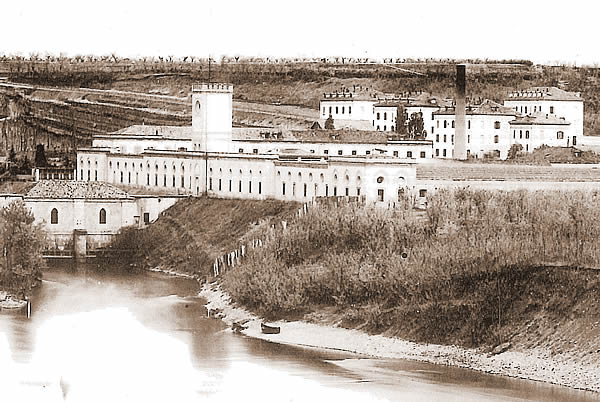歴史とその意義
全ては、二人の啓蒙的な近代産業の旗手、クリストフォロ・クレスピと息子のシルビオが、アッダ川沿いに労働の理想郷を建設しようと考えたことから始まりました。 この小さな村で、領主の城は、工員たちとその家族にとって、権威の象徴であると同時に、温情主義のシンボルでもありました。
クレスピ村は、工員村現象のイタリアで最も重要な例です。世界的にみても、最も独創的且つ、完全な形で実現された工員村の一つで、 特に、当時のままの姿が完全に保存されている点で、貴重な例です。 - 村の構造と、建築的な特徴は、ほぼ当時そのままの状況で保存されています。
クレスピ村は、正真正銘の理想郷のモデルです。 ここはたいへん興味深い、完全に自給自足の小宇宙であり、ここでは、秩序と和という理念の下に、工員生活が、家族生活やコミュニティ全体と共に、 工場を軸として展開されていました。これは、農村社会と近代産業の境界線に築かれた人間サイズのガーデン都市です。
クレスピ村は幻想だったのか?いずれにしても、近代的な産業や住宅、社会の発展に大きく寄与したことは、まぎれもない事実で、 今日でも参考にすべき貴重なモデルを提供しています。

歴史
クレスピ工場と村は、19世紀末から20世紀に至る、正にイタリアで近代産業が生まれた時代に、 綿織物工場の事業主だったクレスピ家の人々によって建設されました。当時は、啓蒙的な思想の影響を受け、 領主であると同時に、温情主義者でもある大ブルジョワの時代でした。
彼らは国家の社会保障制度の手がまだ届かなかった時代に、自らの資金でいろいろな施設や社会的なサービスを無料で提供し、 工場内外における工員たちの生活を保障したのです。
全ての工員に、家庭菜園と庭付の住宅を与え、学校や教会、病院、余暇活動センター、劇場、公共浴場など、コミュニティ生活に必要な全てを無料で提供する、 という考えに基づき、1878年、アッダ川のベルガモ県側の岸辺に建設されました。この温情主義的な実験も、1920年代末に主役たちが舞台を下りると同時に、 20世紀の時代の移り変わりの波を受け、終焉ををむかえることとなります。
今日、村に住んでいる住民は、大部分が当時の工場村の工員の子孫の家族です。工場自体も2003年まで綿織物工場として稼動していました。

«Landscape»
«The environment that surrounds Crespi d'Adda is unique: the village is situated in a cradle, a triangle shaped lowland, which is delimited by the intersection of two rivers to the South and by a difference in level of the ground to the North, called "Fossato Bergamasco".»
«The two rivers are: the Adda and the Brembo, and they form a peninsula called "Isola Bergamasca" (the village is located at the very end of the peninsula). The "Fossato Bergamasco" represented in former times the border between the Duchy of Milan and the Republic of Venice.»
«The geographical isolation is also accentuated by the fact that the village is connected to the outside only from the North. Today these geographical features and the seclusion they implied help us understand why Crespi d'Adda could preserve so extraordinary, hidden and distant from the chaotic development of the surrounding area.»

«Urban Layout»
«The urban layout of the village is extraordinary. The factory is situated along the river, next to the castle of the Crespi family.»
«The workers' houses, of English inspiration, are lined up in order along parallel roads to the East of the factory, and to the South there is a group of enchanting villas for clerks and directors. The houses of the physician and the priest overlook the village from a hill, while the church and the school are placed side by side facing the factory.»
«The presence and the importance of the factory are emphasised by its high chimneys and its sheds that are repeated in a fascinating perspective along the main street. The street itself is also a metaphor of workers' life and it runs between the factory and the village, arriving finally at the cemetery.»

«Architecture»
«In Crespi d'Adda there's a wide range of styles, varying from classicismo to romanticismo.»
«The castle is a reproduction of the medieval style, while the church is the exact copy of the church of S.Maria, of renaissance style, in Busto Arsizio, where the Crespi family was born. All the other constructions are of neo-medieval style, decorated with precious brick ornaments - typical of romanticismo lombardo - and wrought iron finishes. The factory itself is neo-medieval the highest celebration of the industry is expressed by the main entrance, with its magnificent office direction buildings.»
«The cemetery, of exotic taste and eclectic style, is a national monument and it is characterised by the Crespi chapel - a decorated tower-pyramid made of ceppo and cement, which rises to embrace the workers' graves: small crosses disposed in order in the meadow.»
«Protagonists»

CRISTOFORO BENIGNO CRESPI
«Born in 1833, he was the first son of Antonio Crespi, descending from a family of textile producers from Busto Arsizio. Originally he helped his father with the trading of dyed fabrics, but then founded with his family the cotton mills of Vaprio, Vigevano e Ghemme. In 1878 he founded the factory in Crespi d'Adda, introducing the most modern spinning, weaving and finishing processes.»
«In 1884 he moved to Milan, in his house in Borgonuovo street, where he opened the headquarters of his company. He also kept a vast and widely admired collection of paintings.»
«In 1904 he built the hydro-electric power station of Trezzo sull'Adda ("Taccani"). He was awarded several honours, which included "Cavaliere del Lavoro" and "Commendatore della Corona d'Italia". He died in Milan in 1920.»

SILVIO BENIGNO CRESPI
«Son of Cristoforo, he was born in Milan in 1868. He got his degree in law at the age of 21 and spent some years in England in order to follow the developments of cotton production. In 1889 he started working in his father's factory where he became director.»
«With a tenacious and tireless character, he occupied himself with numerous activities, ranging from industrial to the political and financial sectors. He published and authored a study on preventing the injuries at work. He was the first president of the Cotton Producers association and member of "Consiglio Superiore Industria e Commercio". He was president of Banca Commerciale Italiana and of the Italian Automobile Club.»
«He was deputy and senator for the Catholic Liberals and within the Parliament he promoted industry and commerce, with a special concern for workers conditions. He was appointed Ministry Plenipotentiary at the end of the First World War. He died in Cadorago in 1944.»
